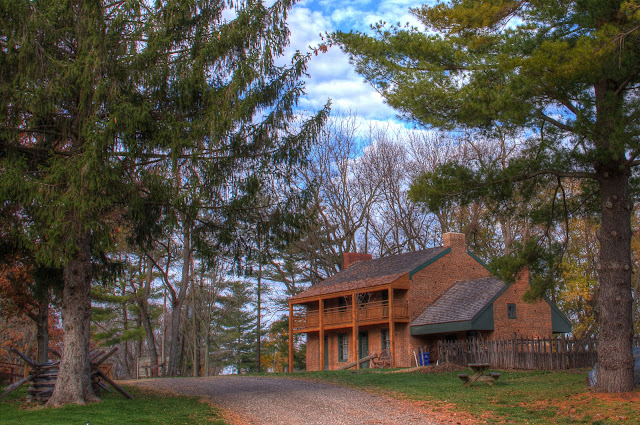The brick house or Inn was built around 1824 in the architectural style of the Federal period, not unlike those of the New Jersey, New York, Pennsylvania and Ohio areas from which Mr. Broadwell had come. The Inn, built with native clay bricks, originally had two two-story wooden porches on its north and south facades. The structure and cabinetwork of this Inn are unusually fine for its day, and the building has been recorded by the Historic American Buildings as an outstanding example of early architecture in Illinois.
Great exposed, hand-hewn center “summer” beams run through the structure at three levels for support. The walnut mantels, cabinetwork and most of the flooring are original, and the doors have great hand-forged strap hinges and large iron or brass locks. The bricks were handmade on the site. A brick oven built into the kitchen fireplace is one of the few beehive ovens in this region where bread or other goods are still baked. Outside, the original hand-dug stone-cased well still has good water. The furniture for the Inn, in addition to its glass, china, pottery, and kitchen gadgets, has been obtained mostly from old families of Sangamo Country. The structure represents a transitional period between the cabin of the rugged pioneer at New Salem and the more comfortable homes of Springfield before the Civil War.
In 1842, the area around Broadwell's Inn was renamed "Clay's Ville" because of the sentiment for the perennial Whig candidate, Henry Clay.
During the heyday of the Inn, Reverend Peter Cartwright often spent time at Broadwell's Inn. In fact, Reverend Cartwright held a large camp meeting at Clayville in 1832. Mentor Graham, Lincoln's teacher, held classes at the Clayville Schoolhouse in 1830 and 1836; and according to Carl Sandburg, it was at this log schoolhouse at Clayville that Lincoln sat and listened to students recite their lessons.
Dr. Charles Chandler, the founder of Chandlerville, was a frequent visitor to Clayville on his way to and from Springfield. Lincoln himself is said to have stayed at the Inn, even though no actual proof exists. Lincoln was the lawyer of the Broadwell family, and it is unlikely that he made the journey from Springfield to confer with his client and returned home all in the same day.
To the traveler, Clayville tavern offered comfort and warmth within its walls. To the Broadwell's, it provided an income that was needed to raise their large family. In addition to the tavern, the Broadwells also operated a store and a tannery nearby on Richland Creek. According to the store daybook, the Broadwell store stocked flour, sugar, molasses, salt, whiskey, gin, nails, dyestuffs and other staples of the day. The tannery ledger shows that approximately twelve men were employed in the tanyard and that this business operation supplied leather to farmers, bootmakers and harness makers.
In addition to the family's businesses, a mill and blacksmith shop and schoolhouse completed this rural community. Ten miles to the north at Sangamo town, the Broadwells operated their own grist mill. (During the tavern restoration, a barrel stencil and stencil brush used by the miller were found under the boards in the stairway.)
Moses Broadwell died in 1827, and the family operations fell on the shoulders of his son John. In 1834, a fire broke out in the Inn and partially destroyed the west end. The tavern was rebuilt, but even today, evidence of the fire can be seen in one of the upstairs bedrooms. After the structure was rebuilt, the family prospered until the advent of the railroads. With the iron horse also came the death of the Clayville community.
All of the businesses at Clayville depended upon the post road and stagecoach line. The post road, which originally opened in 1825 and ran from Springfield to Beard’s Ferry, was extended in 1829 to Quincy on the Mississippi River. With the railroads in the 1850s, the need for a tavern no longer existed, and the Inn became a family residence. The structure was used as such until the 1930s when it became a storage barn for hay. It remained that way until the Pearsons came along.
In 1992 the site was sold into private ownership, and over the next several years deteriorated to a point that in 2007 it was declared one of the ten most endangered historic sites in the State of Illinois.
In 2009, headed by Jim Verkuilen, The Pleasant Plains Historical Society was formed to purchase and save The Clayville Historic Site. In May of 2010, the purchase of the site was finalized.
In 2012, Landmarks Illinois, the organization that in 2007 had declared the site to be one of the most ten endangered sites in Illinois, awarded The Pleasant Plains Historical Society it’s advocacy award for saving the site.
Compiled by Dr. Neil Gale, Ph.D.









No comments:
Post a Comment
The Digital Research Library of Illinois History Journal™ is RATED PG-13. Please comment accordingly. Advertisements, spammers and scammers will be removed.